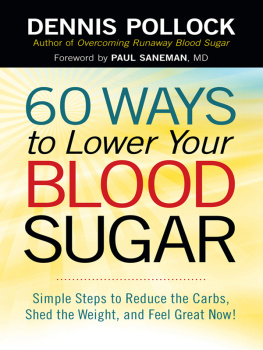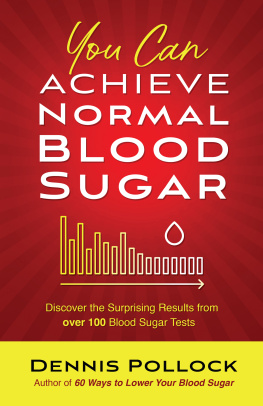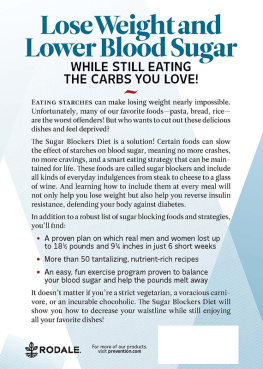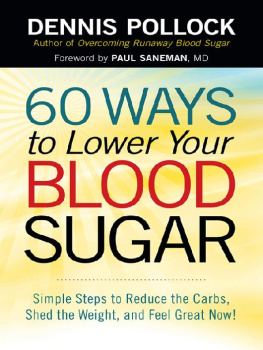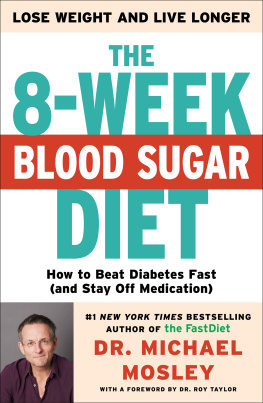

HARVEST HOUSE PUBLISHERS
EUGENE, OREGON
Cover by Koechel Peterson & Associates, Inc., Minneapolis, Minnesota
Readers are advised to consult with their physician or other professional practitioner before implementing any suggestions that follow. This book is not intended to take the place of sound professional advice, medical or otherwise. Neither the author nor the publisher assumes any liability for possible adverse consequences as a result of the information contained herein.
60 WAYS TO LOWER YOUR BLOOD SUGAR
Copyright 2013 by Dennis Pollock
Published by Harvest House Publishers
Eugene, Oregon 97402
www.harvesthousepublishers.com
Library of Congress Cataloging-in-Publication Data
Pollock, Dennis, 1953-
60 ways to lower your blood sugar / Dennis Pollock.
pages cm
ISBN 978-0-7369-5258-3 (pbk.)
ISBN 978-0-7369-5259-0 (eBook)
1. DiabetesPopular works. 2. DiabetesTreatmentPopular works. 3. Reducing dietsPopular works. 4. Low-carbohydrate dietPopular works. I. Title. II. Title: Sixty ways to lower your blood sugar.
RC660.4.P655 2013
616.4'62dc23
2013000620
All rights reserved. No part of this electronic publication may be reproduced, stored in a retrieval system, distributed, or transmitted in any form or by any meanselectronic, mechanical, digital, photocopy, recording, or any otherwithout the prior written permission of the publisher. The authorized purchaser has been granted a nontransferable, nonexclusive, and noncommercial right to access and view this electronic publication, and purchaser agrees to do so only in accordance with the terms of use under which it was purchased or transmitted. Participation in or encouragement of piracy of copyrighted materials in violation of authors and publishers rights is strictly prohibited.
To my sweet lady and my best friend, my wife, Benedicta, who is truly a gift from God to me .
Contents
The relationship of obesity to blood-sugar problems and type 2 diabetes has been known for years. In this country today, the weight problem is epidemic. Just look around the next time you go to a restaurant, supermarket, or anyplace there are lots of people and see how many of them are overweight.
Dieting to lose weight is important, of course, but just what foods are better for your health to accomplish this task? The author has spent much effort selecting not only foods but a lifestyle to deal primarily with his blood-sugar problemand with great success. The changes he suggests are not necessarily easy, but the end result is what is important. Eating a healthy diet will prevent many medical problems and decrease or eliminate the need for expensive medications. As I would tell my patients, all the food God made is good. But, what people do to it may not beand this is manifested by what you see today in this country.
How earnestly do you want to be healthy? How motivated are you? How committed are you? Moderation in all you eat, as well as motivation to select healthy foods, are essential; both are wisely stressed by the author. As you read this book, may you be inspired to deal with your own issues for the sake of your better health.
Paul Saneman, MD, ABOG
Diabetes is on the rise in America. This is not a new phenomenon. It has been steadily increasing for years and shows no signs of letting up. It is projected that within another 50 years one in three Americans will be diabetic.
There is a note of hope in this, however. The fact that the rate of diabetes can increase reveals that there are factors we can controlthings we can do to decrease our chances of becoming diabetic, or if already diabetic, to begin to reverse the process. If diabetes were totally unrelated to lifestyle factors, it would neither increase nor decrease from one age to another, or from one culture to another. This is clearly not the case.
As is true in so many areas of life, our primary problem is not ignorance of what we should do; it is a lack of motivation to do what we know we need to do. In my previous book, Overcoming Runaway Blood Sugar , I shared my own experience with blood sugar that rose precipitously high and dropped dangerously low. By the time I was in my forties my blood sugar was totally out of control. My pancreas was working just fine, but it was being overworked by a body that was no longer processing carbs and sugar efficiently. A high-carb meal could raise my blood sugar to twice the normal level or higher, and then within a couple of hours, after my abused pancreas had gamely dumped prodigious amounts of insulin into my bloodstream, it might fall to half of normal. I would be trembling violently and feeling like I was about to pass out, which I did in public once, to my shock and embarrassment.
At first I had no clue as to what was going on in my body, but had some suspicions that it had to do with blood sugar. After obtaining a blood-glucose monitor, I started checking my blood sugar several times a day. I soon realized that what I put in my mouth an hour or two previously had everything to do with the kind of numbers I was seeing on the monitor. Lots of pasta, a big dessert, and a soda to wash it all down led to disastrous numbers. But a large chef salad with eggs, ham, and garden vegetables, with water to drink, produced beautiful numbers.
Not content to merely observe, I started reading different books and articles related to blood sugar. Trying to stay mainstream, I discovered that the most reputable and conservative authors came to the same conclusions. The three basic means of controlling blood sugar are reducing carbohydrates, regular exercise , and shedding excess weight . Now I had hope! As fearful as those trembling episodes had been, my attitude was, Give me something concrete to do about this, and Ill do it! I plunged into making the necessary changes and was thrilled to see my numbers go down and stay down. They have now been that way for years.
Most diabetics know the steps they must take to bring their blood sugar to a normal state and prevent long-term damage to their body. But making the necessary changes seems just too tall a mountain to climb. Besides, at the present they may feel just fine. They still have pep, they feel greatin fact, after eating a high-carb meal they feel especially good! They do not realize that they are well along on the journey to sores that refuse to heal, heart disease, kidney failure, leg amputations, and premature death. The irony is that the changes they are avoiding, while not unsubstantial, are not nearly as difficult or painful as they think.
This book does not take the place of a good doctor! If you are diabetic you absolutely need to be seeing a doctor. If you suspect you are diabetic you need to go to a doctor and get yourself checked. The ideas in this book are made to complement the advice and care of your physician.
In this little book I intend to put some very simple basic keys in your hand that will help you, step by step, make the necessary changes with the least amount of pain. I have never particularly liked pain. In fact any time I can avoid it, I surely will. The idea of being some kind of a grim diabetes martyr, never enjoying a meal, forcing myself to do physical workouts I hate, never indulging my sweet tooth (actually teeth), and walking away from every meal constantly hungry is something I have no interest in. The good news is its not necessary .
Next page
